Trying to decide between Porterhouse vs t Bone steak? Both steaks have that iconic t-shaped bone. But which is truly the better steak? The good news is that both are delicious cuts of meat if you want a top-quality steak for a romantic dinner or a fun-filled cookout. You really can’t go wrong with either option.
With that said, some differences might make you prefer one over the other (including taste!)
In this article, we’ll explore what a porterhouse steak cut is, what a T Bone steak is, all (and I mean ALL) the differences between the two, and the best ways to prepare and cook each steak. We’ll even cover some tips and tricks to ordering them at your local store.
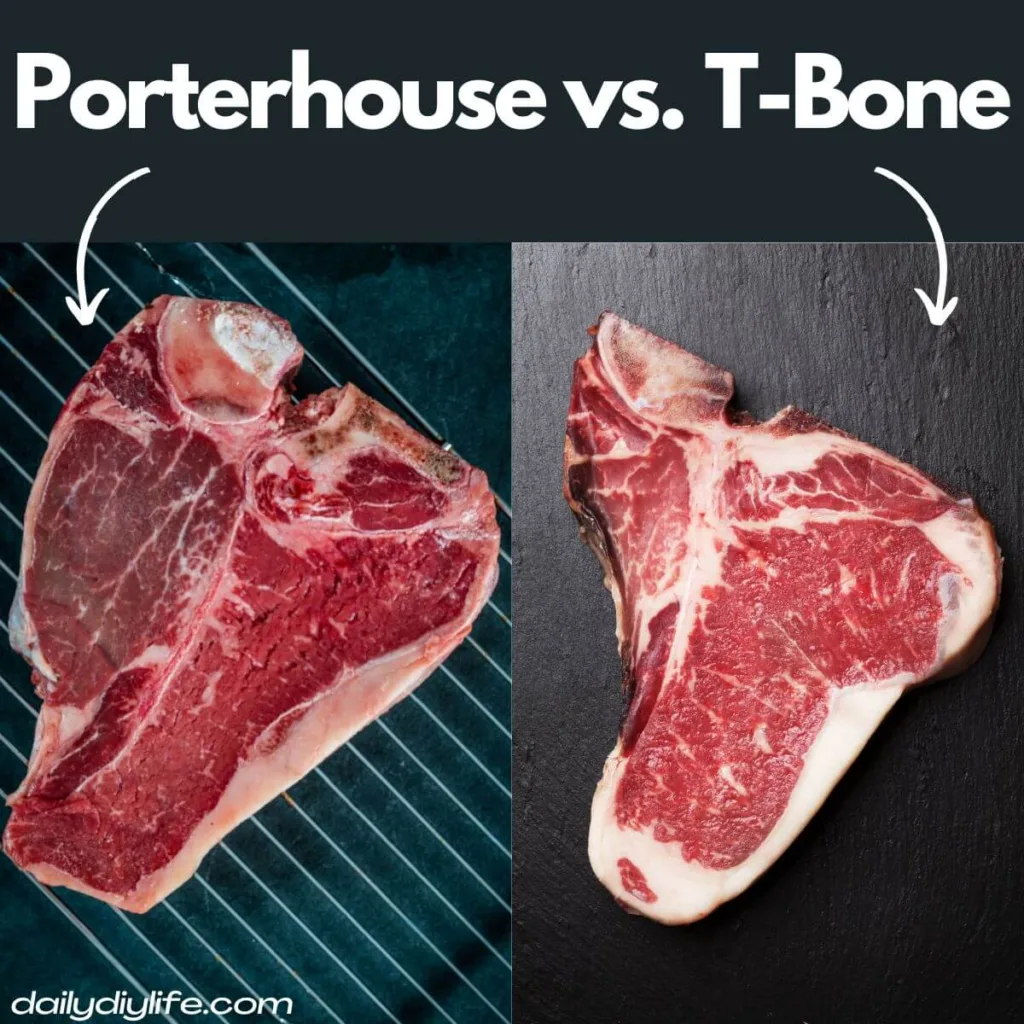
What is a Porterhouse Steak?
A Porterhouse steak is a cut of beef that comes from the tenderloin section of the cow. This cut is located on the back of the cow, near the side of the bone by the hip. This steak gets its name from a specific porterhouse restaurant (what they used to call steakhouses) in NYC, where the cut of meat was first served.
Porterhouse steak, “the king of steaks,” is a massive steak. A single porterhouse can weigh up 2 pounds – that’s because this classic dish consists of both tender filet mignon AND New York Strip meat.
Notice that the Filet portion is large than the filet portion in the T-Bone steak (see T-Bone image above)
It is not just the size that makes this steak so awe-inspiring, but also its tenderness. If you’re looking for an unforgettable meal with your significant other or family member on special occasions, then look no further than this mighty cut of beef!
What is a T Bone Steak?
Right in the middle of the short loin, you’ll find the T-bone. This delectable piece of meat gets its name from the “T”-shaped bone that runs through it (you can see it in Porterhouse steak too).
Smaller than the Porterhouse, the T-bone steak is a Strip and Fillet divided by the bone that makes it look like an “X.” While Porterhouse steaks are cut from the larger end of the short loin, T-bone steaks come from the smaller section of tenderloin. This means that T-Bone steak have a more petite filet mignon.
Despite being smaller than the Porterhouse cut, T-Bone steak still offers something for everyone – those looking to enjoy more tenderness without sacrificing flavor can choose from either fileting or striping, depending on their preference.
The T-Bone is one of those steaks that you can’t miss. It has a distinctively shaped bone running through it, making for easy identification in our meat case and on restaurant menus across America! The beef industry data shows this popular cut was growing quite rapidly during recent years–and there’s no reason to think its popularity will slow down anytime soon either way.
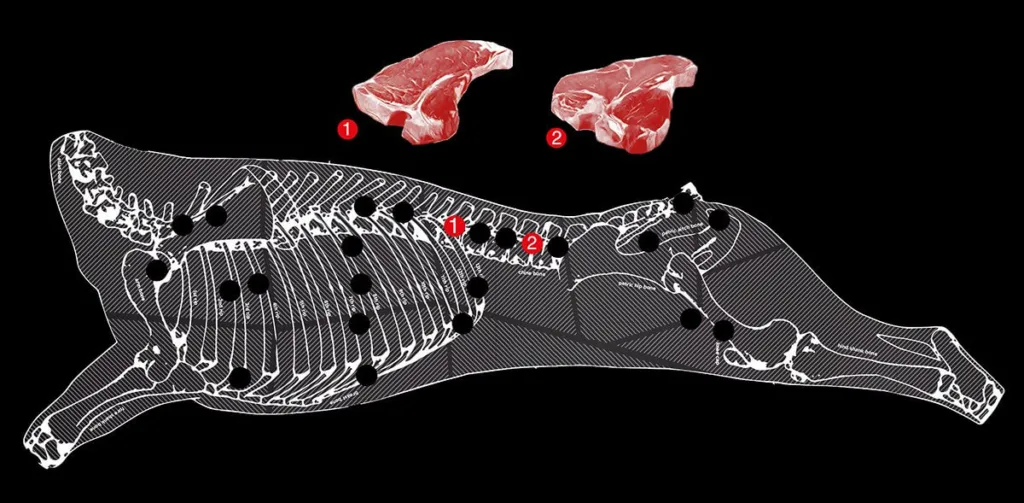
T Bone Steak vs Porterhouse Steak
When it comes down to it, both the T-Bone steak and the Porterhouse steak are similar; both butchers from the back of the cow. The key differences, however, are the following:
- Size.Porterhouse steaks are generally larger than T-bone steaks, typically weighing between 24 and 48 ounces. T-bone steaks, on the other hand, are usually smaller, weighing between 16 and 24 ounces.
- Bone size and shape. The primary difference between the two cuts is the size and shape of the bone. Porterhouse steaks are cut from the rear end of the short loin and have a larger portion of the tenderloin muscle than T-bone steaks. The bone in a Porterhouse steak is shaped like a “T” and has a larger portion of the tenderloin on one side. T-bone steaks are cut closer to the front of the short loin and have a smaller portion of the tenderloin muscle. The bone in a T-bone steak is also shaped like a “T,” but the tenderloin portion is smaller.
- Flavor and texture. Because Porterhouse steaks have a larger portion of the tenderloin muscle, they tend to be more tender and have a milder flavor than T-bone steaks. T-bone steaks, on the other hand, have a larger portion of the flavorful strip steak muscle, which gives them a more robust and beefy flavor.
If I’m being honest, you really can’t go wrong with either choice. Even if you by accident purchase the wrong one (yes, I did that once)! Which you choose really comes down to personal preferences, the size of your appetite (or the amount of leftovers you want), and how much you want to spend.
I once heard a friend, one of those foodie types, say that a Porterhouse steak has a milder flavor. He then said that a T-Bone has a beefier flavor. I don’t think my tastebuds are that evolved, but if yours are, it’s good food for thought!
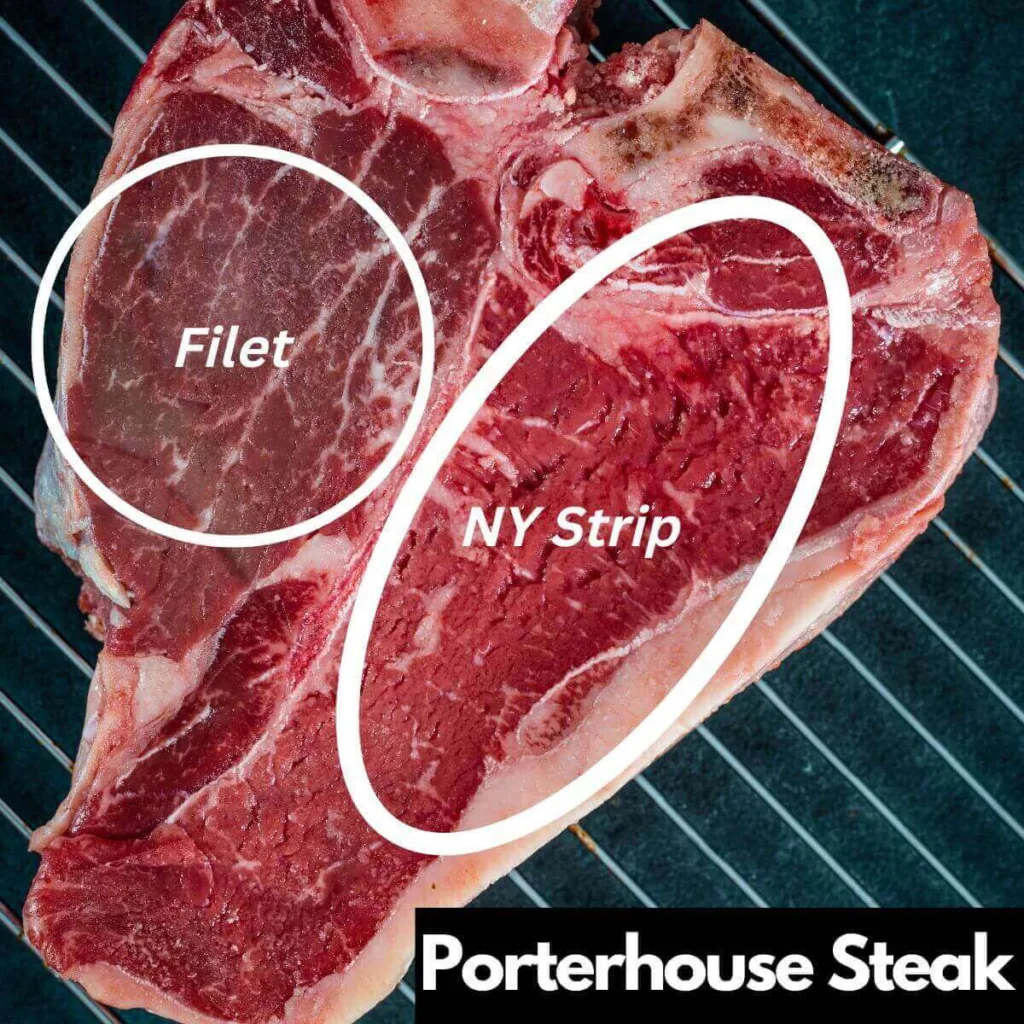
Nutritional Information for T Bone vs Porterhouse
Porterhouse steak and a T-Bone steak are high in both nutrients and calories. Below is a breakdown of the nutritional information of a T-Bone vs Porterhouse steak.
Below is the nutritional information for 100 grams of Porterhouse steak compared to 100 grams of T-Bone steak.
According to the United States Department of Agriculture (USDA) Food Composition Database.
Porterhouse Steak Nutritional Info
Protein: 23.96g
Fat: 19.27g
Calories: 276kcal
T-Bone Steak Nutritional Info
Protein: 27.48g
Fat: 11.05g
Calories: 217kcal
Side by Side Nutritional Comparison
Beyond your typical calories, protein, and fat composition of each steak, there are a few nutritional differences between these two cuts of meat that stand out:
- T bone steak is lower is saturated fat
- T bone steak contains more grams of protein
- While Porterhouse steak is lower in both sodium and cholesterol
Below is a detailed nutritional breakdown between the two.
| Nutrient | Porterhouse | T-Bone |
|---|---|---|
| Protein | 23.96g | 27.48g |
| Fat | 19.27g | 11.05g |
| Calories | 276kcal | 217kcal |
| Calcium | 7mg | 19mg |
| Iron | 2.94mg | 3.57mg |
| Magnesium | 22mg | 20mg |
| Potassium | 299mg | 280mg |
| Sodium | 65mg | 68mg |
| Zinc | 4.56mg | 4.69mg |
| Vitamin B1 | 0.099mg | 0.057mg |
| Vitamin B2 | 0.228mg | 0.27mg |
| Vitamin B3 | 4.21mg | 6.292mg |
| Vitamin B5 | 0.314mg | 0.307mg |
| Vitamin B6 | 0.365mg | 0.758mg |
| Vitamin B12 | 2.18mg | 1.89mg |
| Folate | 7mg | 7mg |
| Saturated Fat | 7.271g | 4.6g |
Price Points
Many factors determine the cost difference between a T-bone or Porterhouse steak. They include:
- The quality of meat
- The weight of the steak
- Whether or not it’s dry aged
- And where you buy it for (for instance, a fancy organic butcher is going to more pricey than, say, you’re local big box grocery store)
In general, however, Porterhouse steaks are more expensive due to their thickness and weight. Porterhouses have a thicker spine than T-bones, which makes them costlier per pound.
However, if your butcher cuts the meat poorly or unevenly, then your price will go down because there’s less meat on one side compared with another (meaning that it becomes cheaper in terms of dollars/pounds).
To be safe, though: make sure every strip has a larger portion before buying any filets, especially since they can vary quite heavily from piece.
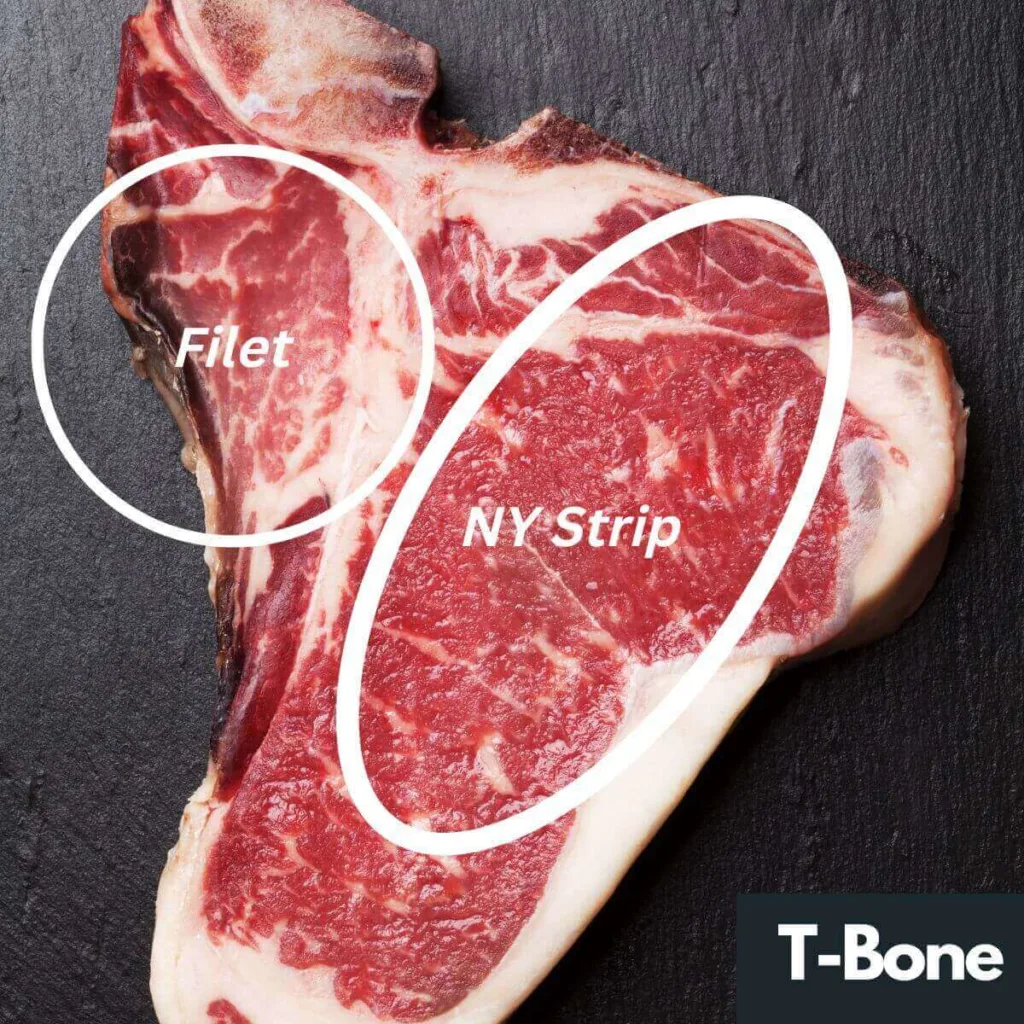
Cooking Methods for T Bones and Porterhouse Steaks
Simply, the best way to cook a Porterhouse or T-bone steak is by following these simple steps. First, season with coarse salt and pepper on both sides of the meat before placing in butter for about five minutes per side over high heat until cooked right through but not burning!
Pro tip: “It’s important to use an instant-read meat thermometer, especially when grilling or smoking because it reads temperature quickly.”
Anthony DiBernardo
(chef and pitmaster of Swig & Swine barbeque restaurant in Charleston, South Carolina)
How to Cook a Porterhouse Steak
A well cooked Porterhouse steak is a thing of beauty and dancing taste buds.
The Porterhouse steak is a cut that benefits from being grilled on a charcoal grill. However, for best results, Porterhouse steaks should be cooked in a cast iron skillet for a good sear.
Because of their thickness, Porterhouse cuts generally take longer to cook than other steaks do. Just make sure not to overcook. You want your meat juicy and perfectly cooked (but still tender).
One trick to cooking steak is to get a good sear on the outside on both sides, then finish it in the oven for a few minutes.
How to cook a T Bone Steak
The T-bone steak is a cut that’s perfect for grilling. The long, narrow bone helps it maintain its structure under the extreme heat of your grill and pressure when you turn them over to cook on both sides evenly without worrying about burning or drying out any part!
Whether you like your steak medium rare, medium, or even rare, you can’t go wrong with either beef cuts.
Where To Purchase Porterhouse and T-Bone Steaks
Best way to ensure you are getting a high quality Porterhouse or T-Bone steak is to purchase the steak from a reputable butcher shop or grocery store. Below are some tips that you should keep in mind while ordering.
Buying High quality Porterhouse Steak
A good porterhouse steak will have deep, rich color and well-marbled meat. When purchasing a Porterhouse steak, you should look for one that has a thick strip of meat with good marbling. The steak should also be a deep red color. You can purchase Porterhouse steak at most grocery stores or butcher shops.
Buying High Quality T-Bone Steak
When purchasing a T-Bone steak, you should look for one that has steak with a deep red color.
The verdict – which one is better, Porterhouse or T-Bone steak?
So when it truly comes to the question: Porterhouse vs t bone, which is best? Since Porterhouse steak is sort of a T-Bone Steak plus more, our preference is that the Porterhouse is a better cut than a T-Bone cut of steak. However, this selection is super close and (as mentioned before) you can go wrong with either one.
Choose a Porterhouse cut if you are looking for cut of meat that:
- Big enough of two
- Has a large filet portion
Choose T-Bone cut if you are looking for cut of meat that:
- Slightly cheaper than a Porterhouse steak
- Has more protein
Have questions about Porterhouse vs T-bone steaks? Leave them in the comments below.

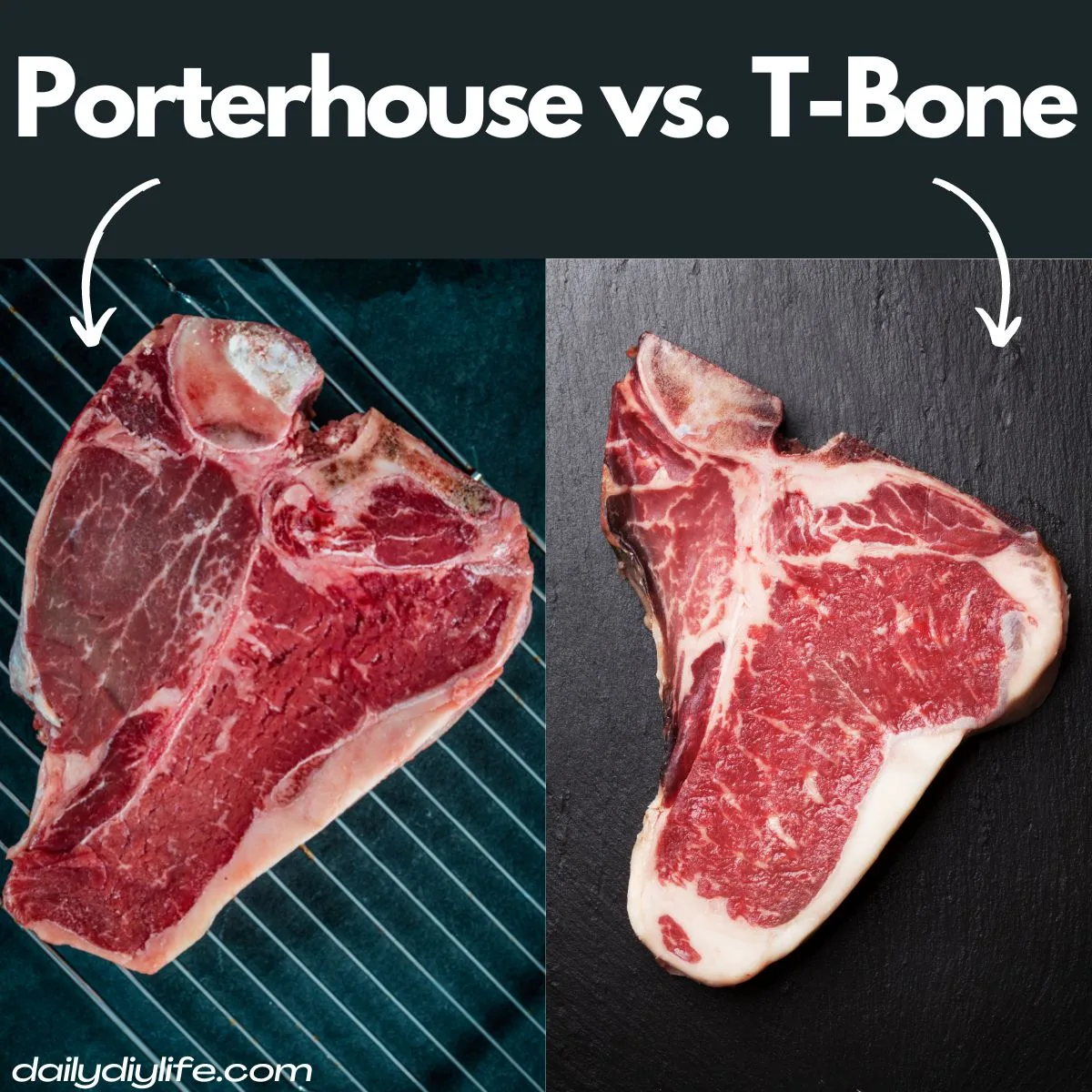
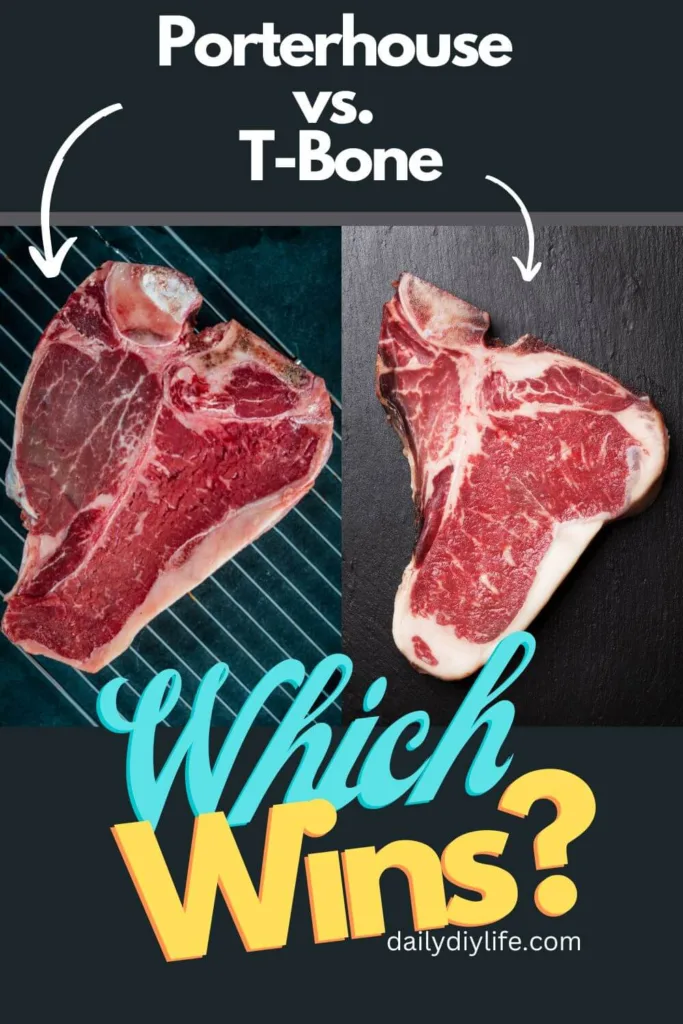
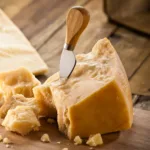


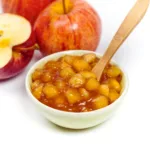
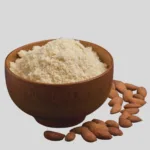

What a fantastic article that delves into the mouthwatering world of steaks! The comparison between Porterhouse and T-Bone steaks is a topic that ignites the passions of meat lovers everywhere, and this post does an excellent job of shedding light on the nuances and differences between these two delectable cuts.
One of the first things that caught my attention was the detailed explanation of the anatomy of both steaks. The distinction between the larger tenderloin portion in a Porterhouse steak and the slightly smaller tenderloin in a T-Bone was particularly enlightening. It’s fascinating to learn how these variations can impact the overall taste and tenderness of the meat.
I also appreciated the discussion on the cooking methods for each steak. The fact that the Porterhouse requires more precise cooking due to the varying thickness of its sections is an important detail to consider when preparing such a magnificent cut of meat. On the other hand, the T-Bone’s more uniform thickness allows for slightly more flexibility in the cooking process. These insights will undoubtedly assist anyone looking to bring out the best flavors from their steak.
Furthermore, the inclusion of tips for selecting and buying these steaks was invaluable. Understanding the USDA grading system and knowing what to look for when choosing a steak can make all the difference in the final result on your plate. The article’s emphasis on marbling, color, and texture helps demystify the steak-buying experience for readers, ensuring they make informed decisions and enjoy their meal to the fullest.
In addition to this insightful article, I would highly recommend reading the complementary post you mentioned from Z Grills’ blog. It provides another perspective and dives deeper into the historical background and regional preferences associated with Porterhouse and T-Bone steaks. Exploring different sources of information allows us to expand our knowledge and make more informed choices when it comes to indulging in these sumptuous cuts of beef.
Overall, I thoroughly enjoyed reading this post and found it to be an excellent resource for anyone passionate about steak. The combination of clear explanations, practical tips, and additional recommended reading material makes this a comprehensive guide for steak enthusiasts at any level of expertise. I’m sure many readers will appreciate the effort and expertise that went into crafting this informative piece.
Thank you for sharing this informative article and recommending the additional reading material. I’m already salivating at the thought of savoring a perfectly cooked Porterhouse or T-Bone steak!